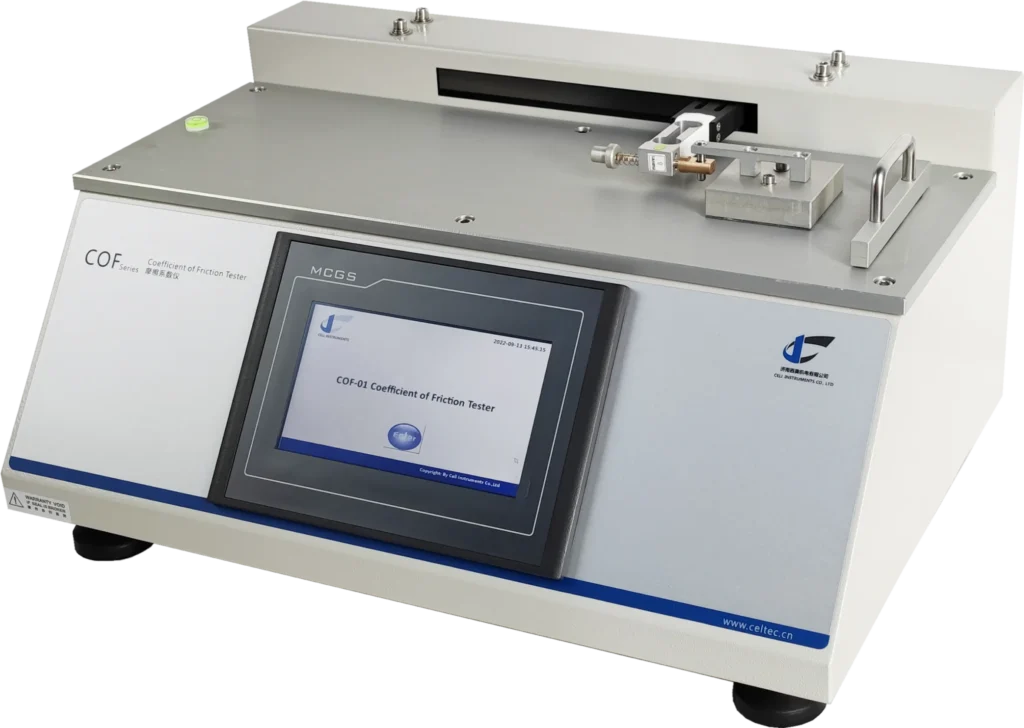
Paper and board — Determination of the static and kinetic coefficients of friction — Horizontal plane method
In industries such as packaging, printing, and paper manufacturing, understanding how materials interact through surface contact is critical. Friction plays a central role in how paper behaves during processing, transport, or end-use. That’s where ISO 15359 becomes essential. As the international standard for determining the static and kinetic coefficients of friction for paper and board, ISO 15359 helps ensure product consistency, operational efficiency, and quality control.
ISO 15359 Overview: What It Regulates and Why It Matters
ISO 15359 specifies a horizontal-plane method for testing the frictional properties of paper and board surfaces. It provides:
- A method to determine the static coefficient of friction (μₛ) — the force required to start sliding.
- A method to determine the kinetic coefficient of friction (μₖ) — the force required to maintain sliding.
These values are essential for evaluating surface behavior during converting, stacking, or feeding processes.
For industries relying on paper and board, ISO 15359-compliant testing helps avoid issues such as paper jams, inconsistent stacking, or packaging defects.
Understanding the Coefficient of Friction of Paper
The coefficient of friction of paper is a material property that quantifies how easily a paper surface slides over another surface. Two types are important:
Static Coefficient of Friction (μₛ): Resistance to initial movement.
Kinetic Coefficient of Friction (μₖ): Resistance during continuous movement.
Paper’s surface texture, coating, fiber orientation, and moisture content all influence these values. Consistent measurement is therefore critical for performance benchmarking and supplier comparison.
Choosing the Right Coefficient of Friction Measurement Device
For accurate results, a coefficient of friction measurement device must meet the ISO 15359 apparatus requirements:
- A horizontal test plane made from an incompressible material.
- A sled applying 2.2 kPa ± 0.6 kPa of normal pressure with a fixed dimension (around 60 mm × 60 mm).
- A load cell with ±2% accuracy to capture peak and average forces.
- Drive mechanisms that can control ramp time between 0.5 s and 5 s.
- Data recording tools to capture transient events like the static friction peak.
Cell Instruments’ COF-01 Coefficient of Friction Tester is ideally suited for ISO 15359-compliant testing. With real-time data display, automated result calculation, and precise mechanical design, the COF-01 ensures reliable testing for both static and kinetic coefficients of friction. The device supports multiple standards, including ISO 8295 and ASTM D1894, and offers flexible configuration options to match various paper grades and forms.
Testing Procedure According to ISO 15359
Here’s a simplified version of how to conduct the test under ISO 15359:
- Prepare Samples: Attach one paper sample to the sled and another to the table. Surfaces to be tested must face each other.
- Set Orientation: Align samples in the machine direction (MD/MD or CD/CD) as needed.
- Lower the Sled: Use a controlled elevator to avoid sliding before the test begins.
- Start the Test:
- Apply an increasing horizontal force until initial sliding occurs — record Fₛ₁.
- Continue controlled sliding to determine the kinetic force (Fₖ).
- Repeat the Procedure: Conduct multiple test runs (at least six) for statistical reliability.
- Calculate Results:
- μₛ = Fₛ / Normal Load
- μₖ = Fₖ / Normal Load
Ensure proper sled guidance and backing materials (such as neoprene) to maintain uniform contact pressure during testing.
Best Practices for ISO 15359 Coefficient of Friction Testing
- Control the environment: Temperature and humidity can significantly affect paper surface friction.
- Use uniform backing materials: Inconsistent backing leads to unreliable pressure and test deviation.
- Check ramp time: It should fall between 0.5 to 5 seconds — results outside this range are invalid.
- Avoid stick-slip motion: If observed, kinetic friction values become unreliable.
- Calibrate your equipment regularly: To ensure compliance with ISO 15359’s ±2% load cell accuracy requirement.
Why Choose our COF-01 for ISO 15359 Testing
Cell Instruments’ COF-01 Coefficient of Friction Tester is engineered for precise and consistent friction testing:
PLC + HMI interface for intuitive operation.
Precision drive system ensures accurate ramp time and velocity control.
Built-in printer and optional software simplify data collection and reporting.
Fully supports ISO 15359 test procedures and apparatus standards.
FAQs
1. What is the difference between static and kinetic coefficient of friction?
The static coefficient (μₛ) measures the resistance to start moving, while the kinetic coefficient (μₖ) measures resistance during movement.
2. Why is ISO 15359 important for paper testing?
It provides a consistent method to evaluate how paper surfaces interact, which is critical for processing and end-use applications.
3. How many tests are required under ISO 15359?
At least six valid test results are needed to ensure statistical reliability.
4. What kind of paper can be tested using ISO 15359?
All types of paper and board can be tested, regardless of coating or thickness.
5. Which instrument is recommended for ISO 15359 testing?
The COF-01 from Cell Instruments is fully compliant with ISO 15359 and is designed for precise, automated friction testing of paper and board.

